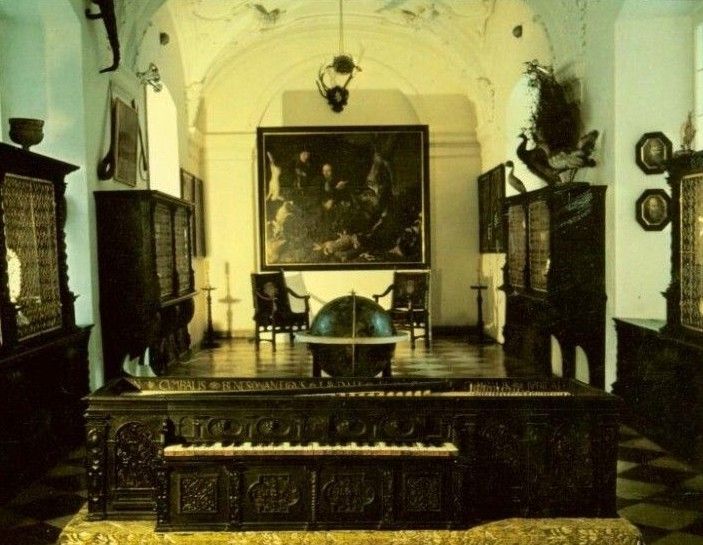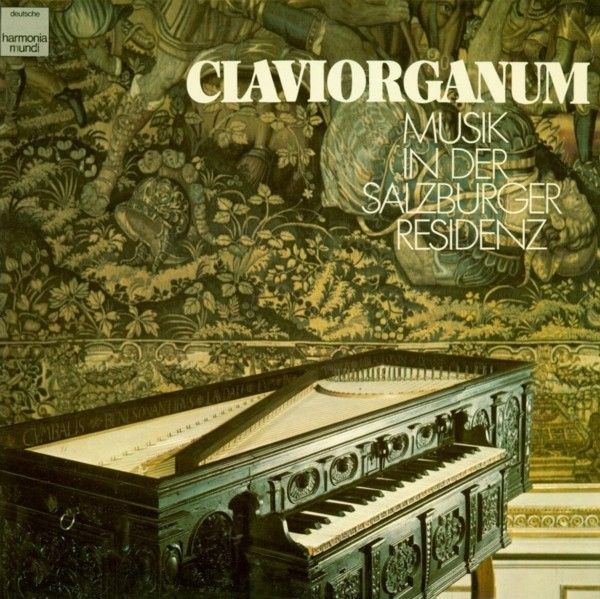
deutsche harmonia mundi 1c 065-99818
1976

deutsche harmonia mundi 1c 065-99818
1976
SEITE 1
01 - Leonhard KLEBER (Tabulaturbuch 1524). Fantasy in fa
[2:21]
C · Flöte, Regal und Spinett
[4:40]
02 - Paul HOFHAIMER (1459-1537). Carmen magistri Pauli
[1:40]
B · Flöte
03 - Ludwig SENFL. Im Maien, im maien [1:10]
C · Vokalquartett, Spinett und Laute
04 - Bernhard SCHMID d. Ä. Ein guter Dantz [1:30]
B · Regal und Spinett
05 - Muenchener Lautentablulatur (um 1540). Ein guet Dantz 'Der
Petler' - Der Hupfafuff [1:08]
Laute
06 - Christian ERBACH (um 1570-1635). Canzona noni toni
[3:05]
B · Flöte
07 - Alessandro POGLIETTI († 1683). Capriccio 'vber dass
Hennergeschrey' [1:58]
B · Regal und Spinett
08 - Francis PILKINGTON (um 1562-1638). Rest sweet Nimphs
[2:13]
C · Tenor und Spinett
09 - William BYRD (1543-1623). Fantasia [5:37]
C · Spinett
SEITE 2
10 - Bernardo STORACE (17. Jh.). Balletto [2:35]
A · Flöte und Spinett
[5:53]
11 - Thomas CRECQUILLON († 1557). Chanson [2:02]
A · Sopran und Spinett
12 - Jacques Champion de CHAMBONNIÈRES († 1672). Sarabande
'Jeunes Zéphirs' [3:38]
A · Double Spinett
[6:37]
13 - Alonso de MUDARRA (um 1508-1580). Gallarda [1:20]
Laute
14 - Juan Bautista CABANILLES. Tiento de Battaglia [5:10]
A · Regal und Spinett - Spinett - Flöte und Spinett -
Tutti
Johannes von LUBLIN (Tabulatur um 1540)
15 - Conradus - Poznanie - Haÿduczkÿ - Ad novem saltus
[3:05]
D · Regal - Flöte - Flöte und Spinett - Regal und
Spinett
16 - [2:46]
Clavierbuch der Regina Clara im Hopf (1629). Böhmnischer Tantz
- Nachtanz
D · Flöte - Flöte und Spinett
Dobrensky Sammlumg, Prag (16. Jh). Písnička přikladná
Vokalquartett
Jacob PAIX (Tabulatur 1583). Ungaresca - Saltarello
D · Regal - Regal und Spinett
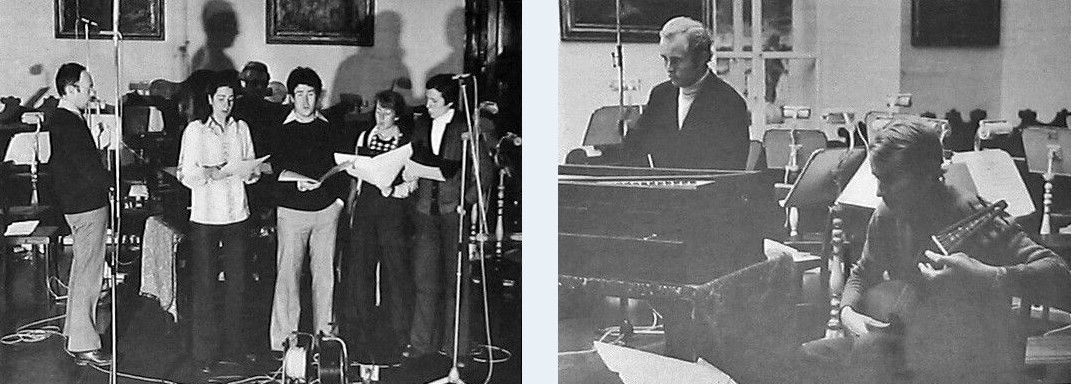
AUSFÜHRENDE:
Gabriele Sima, Sopran
Margot Sturm, Alt
Reinhard Salamonsberger, Tenor
Werner Hahn, Baß
Heribert Metzger, Claviorganum (A)
Henrike Riedl, Claviorganum (B)
Wolfgang Walter, Claviorganum (C)
Gerhard Walterskirche, Claviorganum (D)
Wolfgang Guttman, Laute
CLAVIORGANUM in der
Kunst— und Wunderkammer des Dommuseums zu Salzburg
© 1976 harmonia mundi
Aufnahmeort: Salzburg, Residenz
Aufnahme: Dr. Th. Gallia/P. Dery
Technik: Sonart
Übersertzung: D. D. Jones
EMI ELECTROLA
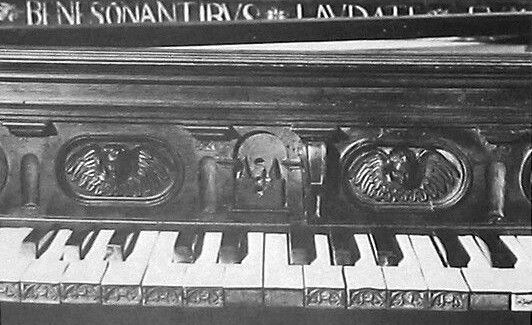
COMMENTS TO THE
PROGRAMME
There is no specific repertoire for claviorganum, and there is no local
connection of any kind in this instrument's tradition. Among the
"playable" literature from the fund of European keyboard music of the
16th and 17th centuries, our instrument shows a leaning towards
intimate pieces with delicate lines: the typically linear ricercar or
carízona, the playful ornamentation of the set of variations, or
the rhythmic agitation of the dance suite is more suited to it than the
heavy technique and passage-work of the toccata. Tablatures too form a
legitimate part of the available music — keyboard instruments,
after all, took part in all music written at that time, and equally,
composers frequently intended one and the same piece both for solo and
ensemble playing. The community between organ and ensemble music is
further illustrated by the fact that the older organ music was
sometimes published in part-form and had first to be set down, i. e.
rewritten in a tablature suitable for the instrument. The succession of
pieces in the tablature books shows clearly what was played: music for
ecclesiastical and entertainment purposes alternates in a colourful
mixture. "An instrumental part-book is not a virgins' book. So no-one
should look for courtly discipline in it", as Christoph Lafelholtz
explains in his 1585 manuscript tablature.
The "Fantasy by the Pforzheim organist Leonhard Kleber reveals itself
to be independent of vocal models, but inspired by the nimbleness of
the fingers and the technical possibilities of the instrument. Through
its dedication to Cardinal Matthäus Lang in Salzburg, its place of
composition is as clearly stated as in the three-part "Carmen" of the
Salzburg-born composer Paul Hofhaimer. The Canzona by the Augsburg
Fugger-organist Christian Erbach shows similarly sublime expression; in
its fan-like structure, it strongly recalls the ensemble canzone of the
period. In the lute tablatures. too, dance-forms predominate. On these
models there developed an independant art which grew as the instrument
and its technique were increasingly understood. How various were the
forms it took in 16th century Poland is shown by the extensive book of
tablatures of Johannes von Lublin, canon of the monastery at Krasnik,
whith was put together between 1537 and 1547. The astonishing European
expansion towards Poland must be seen in the context of the activities
of Heinrich Fink, who was also briefly employed in Salzburg, as
director of the court choir in Cracow. Strangely enough, in Hungary and
Bohemia. corrresponding works have not remained extant in their land of
origin. What has come down to us, however, is the fashion at the
princely courts of Europe of dancing "in the Hungarian style" or of
putting together "Balli" from Hungarian themes. The basic model is
embodied in the "Ungarescha" from the tablature book of Jacob Paix,
1583.
While music for the virginals is representative of this particular
art-form in Elizabethan England — in his "Fantasia", William Byrd
is concerned with constantly changing forms of playing — in the
France of the 17th century, Chambonnières' dances for clavecin
conjure up a bouquet of exquisite sound-pictures. And the musical
exchange between Austria and Spain can also be described as
"blossoming" in the time of Ferdinand I and of his son, Maximilian II.
Cabanilles' warlike Tiento shows strong programmatic tendencies, as
does Foglietti's musical poultry-yard scene. That both conjure up
plastic images, with greater meaning than purely illustrative music,
speaks for their quality. Finally, Storace's "Balletto" is an amiable
example of the southern Italian school, standing midway between the old
style of Frescobaldi and the new style of Pasquini.
The art of solo singing, which had blossomed remarkably in the middle
ages in the songs of the troubadours, trouvères and
minnesingers, was now taken up once more — with instrumental
accompaniment. While the chanson of Charles V's Franco-Flemish musical
director in Brussels, Thomas Crecquillon, is loaded with melancholy,
Pilkington, the Englishman, is wishing all girls sweet dreams. In the
song-settings of the Swiss-born Senfl, and in those of Czech origin,
the existence of a text in each voice-part points to a completely vocal
performance.
The determining factor in fixing the programme was the repertoire of
the 1975 concerts in the "Kunst- und Wunderkammer" (Chamber of Arts and
Marvels) in the Salzburg Cathedral Museum, under the title "European
Keyboard Music". The variety of the As a solo, ensemble and
accompanying instrument could thus be demonstrated by using all the
available resources — all performers being members of the
Institute of Musicology at Salzburg University.
Gerhard Walterskirchen
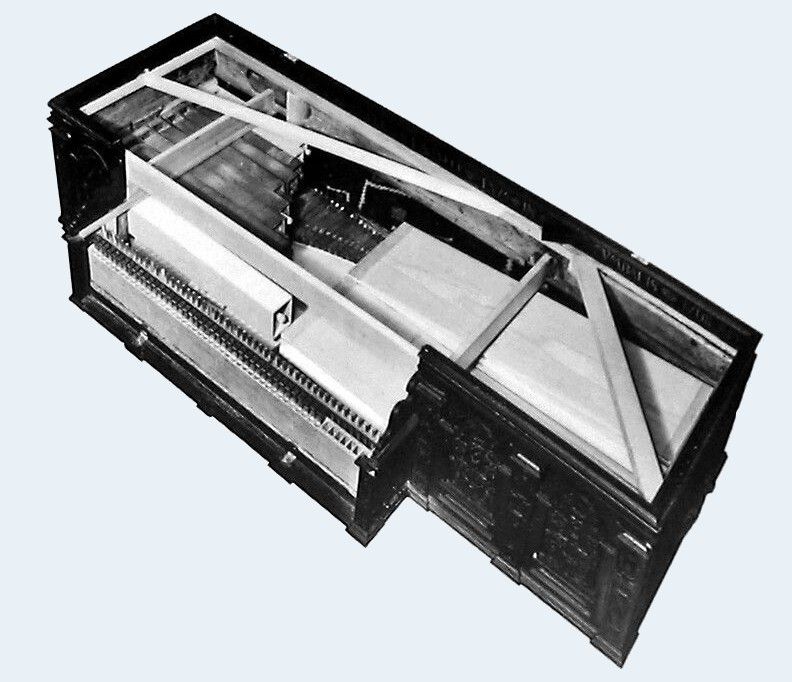
DESCRIPTION OF THE
INSTRUMENT
The instrument is a combination of flue-work (4' gedackt flute), regal
and spinet. All three can be played on a single manual, both
individually and in all conceivable combinations, up to and including
the "tutti", flues + regal + spinet, i. e.: Flute, regal, spinet (all
individually), and flute + regal, flute + spinet, regal + spinet, flute
+ regal + spinet. Further combination variants are made possible by
slider coupling of the flute and regal (at d'/d sharp').
The spinet, an 8' instrument, has a compass of C/E to f''' over fifty
keys. The fluework comprises a gedackt 4' flute in maplewood, with a
compass of C/E to f'''. The 8' regal comprises 42 notes, C/E to a".
While the spinet could be reconstructed on the basis of the remaining
integral parts of the original (bridges, soundpost, cover), late 16th
century models typical of the period were used in the reconstruction of
the lost original regaL Of the original complement of 50 flue-pipes,
only seven were missing, and three proved to be later additions. Traces
of an older bellows arrangement led to the conclusion that there must
have been a pair of multi-folding wedge-shaped bellows (with an
accumulator channel with check valves) inside the body of the
instrument. The wind supply was correspondingly reconstructed with two
wedge bellows (with five folds) to the right inside the body. The
bellows are raised by two cords which are led through the right-hand
wall of the case. The organ mechanism can be disengaged by pulling the
keyboard forward; the spinet jacks can be raised together by means of a
stop which passes through the kit-hand side of the case, thereby
disengaging the spinet. Stops for the slider coupling of regal and
flues can be found to right and left on the underside of the sliding
keyboard.
The signature is found on the inside of the end-board: JOS. POCK
ORGLMACHER ZU INSPRUG (Jos. Pock Organ-builder, Innsbruck), and the
city arms of Innsbruck on the front. The spinet cover bears the
inscription SIC TRANSIT GLORIA MUNDI MDLXXXXI. A further inscription
— running round the inside of the rim — reads: LAVDATE
DOMINUM IN CYMBALS BENE SONANTIBVS LAVDATE EVM IN CYMBALIS IVBILATIONIS
OMNIS SPIRITVS LAVDET DOMINUM (Psalm 150).
The body, in alder wood, is richly furnished with mounted pilasters and
arcatures, and the panels are decorated with scrolls and strongly
stylized acanthus motifs. On the narrow sides there are two carrying
handles in wrought-iron. The lid (which is not original) is executed as
a frame with two panels, lined with silk. The whole cast is stained
black, with gold inscriptions. The keyboard projects over a lower
section which like the back wall of the body, can be opened by means of
a hinged lid. The lower keys of the keyboard itself are in oxbone,
the upper ones in veneered ebony. Dimensions:
Total width, 138 cm
Body depth, 45 cm
Total depth, 55 cm
Height of body, 32.5 cm
Keyboard width, 72 cm
Gauge, 50.4 cm (width of 21 lower keys)
The 4' flute pipes are arranged — in modular form —
lying inside the body; the wind feeds are set into the floor of the
instrument. Right at the top of the body lies the (new) sounding-board
for the spinet. The short, open brass resonators of the regal stand
upright in a row beneath the keyboard.

THE SALZBURG CLAVIORGANUM BY
JOSUA POCK BUILT 1591
During the opening of the Salzburg Dom-Museum, a musical instrument
came to light which, having been among the possessions of the age-old
Abbey of St. Peter, had more or less vanished from contemporary
consciousness during almost two hundred years. Noted down already in
the middle of the 18th century as 'damaged' in the archiepiscopal
'Chamber of Arts and Marvels', it had survived being hidden away during
the 19th and 20th centuries right up to the present day, practically
unnoticed and untouched. After its rediscovery in 1972, it soon became
clear that it was a most unusual instrument, a claviorganum, and indeed
a quite exceptional example of this hybrid variety (by 'claviorganum'
we understand the combination of an organ and stringed keyboard
instrument, with a manual in common, cp. 'Description of the
instrument').
From the signature on the instrument, there is no doubt about its
builder, origin or age.
The builder, Josua Pock, presumably a son of Erasmus Pock (Bock), a
singer in the Imperial Chapel who came to Innsbruck in 1565 and there
entered the service of the Archduke Ferdinand II of Tirol, must have
been born around 1550 (—1560). The family name appears in
contemporary sources in a variety of spellings (Pock, Bockh, Peck, Beck
and so on). But the signature of the instrument ("Jos. Pock") and the
forname "Josua" — the family name is here given as "Bockh"
— entered in the parish register of births of Salzburg cathedral
(on the occasion of the christening of a son in 1593), taken together,
speak for the name "Josua Pcok". Between 1578 and 1582, Josua Pock
worked in Innsbruck as journeyman to the organ-builder (and organist)
Servatius Rorif. After a disagreement with him, Pock finally set up
independently. On 29th July 1585 Archduke Ferdinand granted him a
charter: Josue Pock was permitted to settle in Innsbruck with his wife
and child, in order to carry on his craft and skills in organ-building
and instrument-making, as also the craft of carpenter and cabinetmaker.
In the years that followed, Josua Pock repaired a number of organs in
the Tirol (Schwaz, parish church; Innsbruck, parish church) and built
new ones (Hall I. T., convent of Our Lady). But even before he settled
in Innsbruck, Josua Peck had reconstructed an instrument for the
Archduke Ferdinand which is described as a two-manual harpsichord with
regal — i. e. a claviorganum — and he himself had made a
writing-table with built-in organ for the Archduke in 1584. After this,
it delighted the master organ builder and instrument-maker, carpenter
and cabinet-maker again and again to produce a constructive combination
of a stringed keyboard instrument and organ, or of a keyboard
instrument and a piece of furniture.
Our present instrument may be said to represent a masterpiece (cf.
Description of the instrument). How this instrument, built in
Innsbruck, completed there in 1591 and — as the motto inlaid
before the date, SIC TRANSIT GLORIA MUNDL makes clear —
originally intended for Archduke Ferdinand, actually came to be in
Salzburg can be settled with some certainty from contemporary sources.
Tensions arose between Pock and Archduke Ferdinand after its compktion
in the Willed 1591/2, at which Pock — in the wake of an exodus of
musicians from Innsbruck — moved to Salzburg. Perhaps our present
instrument smoothed his way. For Archsbishop Wolf Dietrich very
probably acquired the claviorganum straight after Pock's arrival in
Salzburg, and had it placed in his private rooms. No doubt he was
attracted in equal measures by the refinement of the "instrument's"
construction, the artistic quality of the decoration of this "piece of
furniture" and the variety of musical possibilities. Its existence in
the archiepiscopal residence can be demonstrated by means of the 17th
century inventories, for example, it appears in 1619 as "ein schwarz
Cässtl von Eben Holz
Holz darin ain orglwerch" (A black box of ebony wood, an organ inside
it) under the rubric 'Writing-table (!) and Organ". A hundred years
later the curious instrument was to be found in the "Chamber of Arts
and Marvels" of the Salzburg Archbishops in the "Great Gallery against
S. Petrer's" (above the southern arches of the cathedral). After its
expert and carefully executed restoration in 1973 by the academic
restorer Peter Kukelka, the instrument returned to this same place.
Since then it has unfolded its surprising, almost wondrous
possibilities when — during visits, or in the concerts which has
been specially organised since the summer of 1974 — a
players's hand have released first, say, the sounds of the spinet, and
then suddenly the soft voice of the flute or the metallic regal, each
voice on its own, one after the other, in varying combinations and
divisions of the manual and then finally all the voices together in a
harmonic mixture never before heard.
